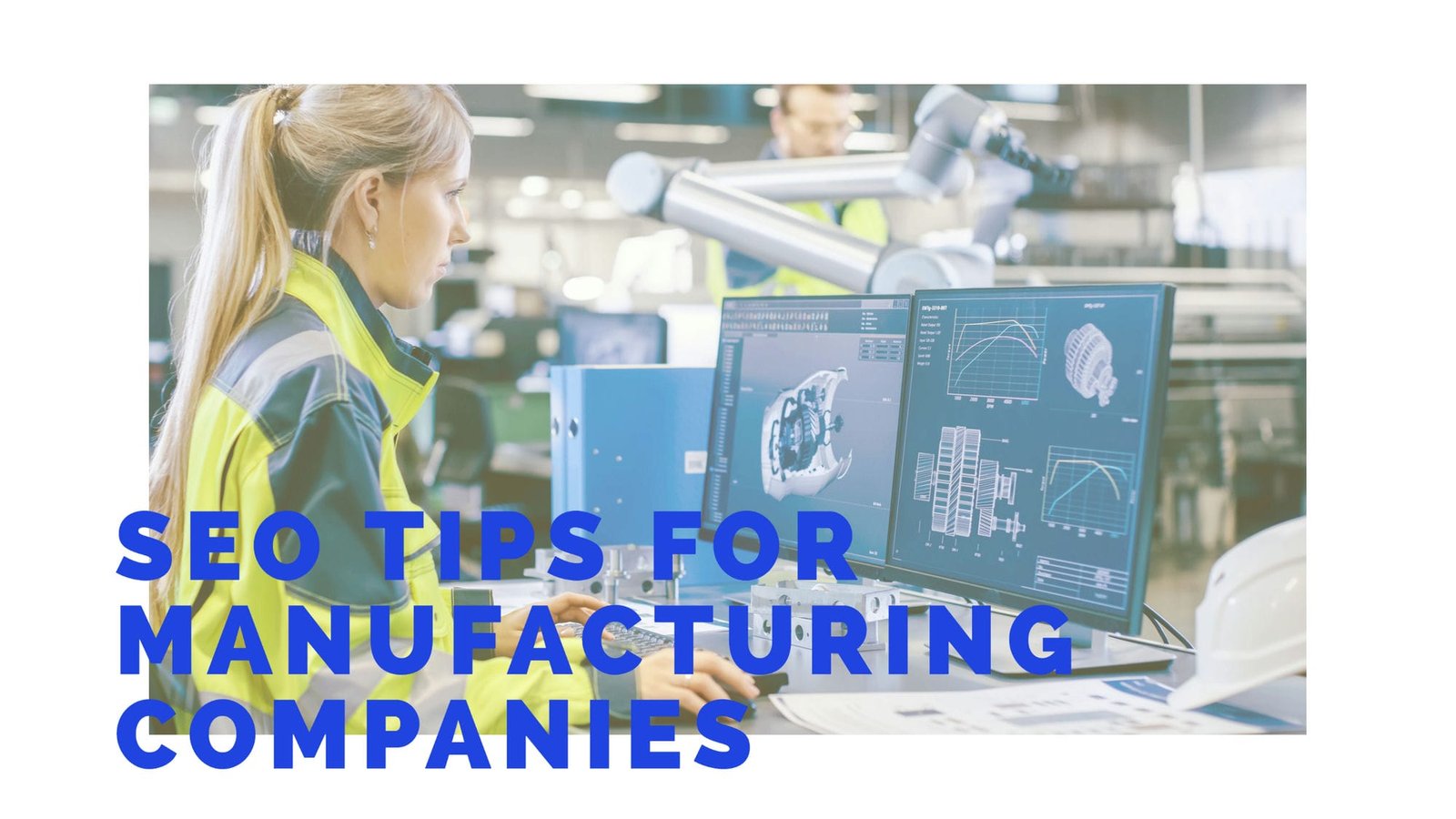
If you’re a manufacturing company, then you know that online marketing is essential to your success. You may be wondering how to best optimize your website for search engines. In this blog post, we will discuss some SEO tips that are specific to manufacturing companies. We’ll cover topics such as keyword research, search intent, on-page optimization, and link building. Following these tips will help you improve your website’s visibility in search engine results pages and generate more leads from potential customers!
Write for people, not just search engines
It’s important to remember that SEO is about more than just keywords and rankings. Your ultimate goal should be to write content that appeals to both users and search engines. By writing interesting and engaging content, you’ll not only improve your website’s ranking, but you’ll also draw more visitors to your site.
Be helpful and informative
When it comes to manufacturing, potential customers may have a lot of questions. They’ll want to know things like what your company specializes in, how your products are made, and what sets you apart from the competition. Your goal should be to answer these questions as thoroughly and clearly as possible. Not only will this help improve your website’s ranking, but it will also build trust with potential customers and help convert them into leads.
Keyword Research
One of the most important aspects of SEO is keyword research. You need to make sure that you are targeting the right keywords with your content. This can be a challenge, especially if you produce a wide range of products. Try to think about the terms that potential customers would use when they are searching for your products or services. For example, if you make car parts, someone might search for “car parts manufacturer” or “car parts supplier.” Once you have a list of relevant keywords, you can start incorporating them into your website content.
Search Intent
It’s also important to consider search intent when optimizing your website. This is what the user is looking for when they perform a search query. There are four main types of search intent: navigational, informational, transactional, and commercial investigation. Make sure that your website content aligns with the type of search intent that users are likely to have when they are searching for your products or services.
Navigational Intent:
This type of search intent is when the user is looking for a specific website or webpage. For example, they may use a branded search such as “Acme Corporation” if they are looking to visit your company’s website.
Informational Intent:
This type of search intent is when the user is looking for information about a topic. They may use keywords such as “how to” or “what is.” For example, someone might search for “how to install car parts” if they need information on how to do it themselves.
Transactional Intent:
This type of search intent is when the user is looking to make a purchase. They may use keywords such as “buy,” “order,” or “purchase.” For example, someone might search for “order car parts online.”
Commercial Investigation Intent:
This type of search intent is when the user is researching a purchase. They may use keywords such as “compare,” “reviews,” or “prices.” For example, someone might search for “compare car parts prices” if they are trying to find the best deal.
Mixed Intent
Some searches may have more than one type of intent. For example, a search for “car parts” could be either informational or transactional in nature. It’s important to consider all possible types of intent when optimizing your website for search engines.
On-Page Optimization
After you’ve done your keyword research, it’s time to focus on on-page optimization. This means making sure that your website is structured in a way that is easy for search engines to understand. Start by ensuring that all of your website’s pages are accessible from the main navigation menu. Then, make sure that each page has a unique title tag and meta description. These elements should include your target keywords and give potential visitors a brief overview of what they can expect to find on your page.
Link Building
Link building is another important aspect of SEO for manufacturing companies. In order to rank well in search results, your website needs to have links from high-quality websites. One way to get these links is by guest blogging on other websites in your industry. You can also reach out to other businesses and ask them to link to your website. If you have a blog, make sure to share your content on social media and other online platforms. This will help increase your website’s visibility and draw more visitors to your site.
Title Tags
One of the most important on-page optimization elements is the title tag. This is the text that appears in the search results, so it’s important to make sure that it includes your target keywords. Keep your title tags short and to the point. Include one or two of your target keywords, but don’t stuff them full of keywords.
Meta Descriptions
Another important on-page optimization element is the meta description. This is a brief description of what users can expect to find on your page. Like the title tag, the meta description should include your target keywords. However, you also want to make sure that it’s interesting and engaging enough to persuade users to click through to your website.
Internal Linking
Internal linking is a process of linking one page on your website to another. This can help improve the navigation of your site and make it easier for search engines to crawl and index your pages. When internally linking, be sure to use keyword-rich anchor text. This will help improve your website’s ranking for those keywords.
External Linking
External linking is the process of linking to other websites from your own. This can help improve your website’s popularity and draw traffic from other sites. When externally linking, be sure to link to high-quality websites that are relevant to your industry.
Sitemaps
A sitemap is an XML file that contains all of the URLs on your website. This file helps search engines crawl and index your website. You can create a sitemap using a plugin or by manually adding your URLs to the file. Once you’ve created your sitemap, be sure to submit it to Google Search Console.
Robots.txt
The robots.txt file is used to tell search engines which pages on your website they should and shouldn’t crawl. This file should be placed in the root directory of your website. Be sure to include a link to your sitemap in this file so that search engines can find it.
High Quality Content
Creating high-quality content is one of the best ways to improve your website’s ranking in search results. When creating content, be sure to include your target keywords and make it interesting and engaging for users. You should also regularly update your content to ensure that it stays relevant.
404s
A 404 error occurs when a user tries to access a page that doesn’t exist on your website. When this happens, you should redirect the user to a relevant page on your site. You can do this by using a 301 redirect. You should monitor your website for 404 errors and correct them as soon as possible.
Website speed
Website speed is a factor that search engines take into account when ranking websites. If your website is slow, it will likely rank lower in search results. There are a few things you can do to improve your website’s speed, such as optimizing images and using a caching plugin.
Mobile-friendliness
Another factor that search engines take into account is whether or not your website is mobile-friendly. With the majority of users now accessing the internet on mobile devices, it’s important to make sure that your website is responsive and can be viewed on all screen sizes. You can test your website’s mobile-friendliness using Google’s Mobile-Friendly Test tool.
Add FAQ sections to your website
Frequently Asked Questions (FAQ) sections are a great way to provide information to users and improve your website’s ranking in search results. When creating FAQs, be sure to include your target keywords. You can also use this opportunity to link to other pages on your website.
Analytics
Finally, it’s important to monitor your website’s performance using analytics. This will help you identify any areas that need improvement and track your progress over time. Google Analytics is a free tool that you can use to track your website’s traffic and performance.
SEO Frequently Asked Questions
How often should I update my website’s content?
It’s important to regularly update your website’s content to ensure that it stays relevant. You should aim to update your site at least once a month.
What is the importance of website speed?
Website speed is a factor that search engines take into account when ranking websites. If your website is slow, it will likely rank lower in search results.
Is mobile-friendliness a ranking factor?
Yes, mobile-friendliness is a ranking factor. With the majority of users now accessing the internet on mobile devices, it’s important to make sure that your website is responsive and can be viewed on all screen sizes.
How do I create high-quality content?
When creating content, be sure to include your target keywords and make it interesting and engaging for users. You should also regularly update your content to ensure that it stays relevant.
Manufacturing SEO Tips Conclusion
By following these tips, you can improve your manufacturing company’s website SEO and draw more visitors to your site. However, SEO can be a complex and time-consuming process. If you need help with your SEO efforts, contact an experienced digital marketing agency like Graticle. We can provide guidance and support to ensure that your manufacturing company’s website is optimized for success.
Call Today (360) 450-3711





